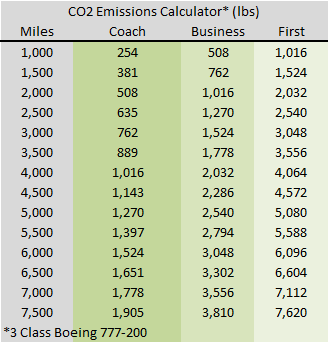How much carbon dioxide does an airplane create? Here’s the equation: 2 C8H18 + 25 O2 -> 16 CO2 +18 H20. Each gallon of JP8 – Kerosene – or jet fuel, weighs about 6.5 pounds. A gallon will combine with 23 pounds of Oxygen and generate twenty pounds of CO2. In practical terms wide-body flights on long haul routes will generate their take-off weight in Carbon Dioxide.
Here’s the detail. First, jet fuel, or Jet A, or JP8, contains a blend of different carbon-based molecules that combine with Oxygen to generate heat and pressure that jet engines convert to thrust. For simplicity, I’ll ignore the blend, and assume that “Octane”, a string-like molecule that contains a backbone with eight carbon atoms and eighteen Hydrogen atoms along the sides and endcaps, is a good proxy for everything else in the gas tank. During the combustion reaction, each carbon atom will combine with two Oxygen atoms to form Carbon Dioxide (CO2), while the Hydrogen will also combine with Oxygen, but their marriage yields water (H20). The reaction balances when two Octane molecules react with twenty-five Oxygen molecules (O2) which contain two Oxygen atoms. The exhaust product contains sixteen Carbon Dioxide molecules and eighteen water molecules. Here’s the equation again: 2 C8H18 + 25 O2 -> 16 CO2 +18 H20.
This detail isn’t useful until we convert molecular weights and ratios into terms that people are more familiar with. We know jet fuel weighs about 6.5lbs per gallon, and that mass is 81% carbon. We already know that our Octane molecule will split to form water and CO2, but the result most people struggle with is the conversion to weight. Specifically, Oxygen is heavy, about a third heavier than Carbon, so when each Carbon atom combines with two Oxygen atoms, the resulting molecule, CO2 is four times heavier than the Carbon atom by itself. This means each gallon of jet fuel (6.5lbs) will combine with 23lbs of Oxygen and turn into twenty pounds of CO2, and just over nine pounds of water!
How much CO2 does a Boeing 777-200 create on a flight between Chicago and Hong Kong? Let’s work through it – fuel is a liquid, and measured in gallons, but the exhaust is a gas, that’s why we use weight rather than volume to describe the output. I calculated the 777-200’s gas mileage in a previous post that compared a Boeing 737 against a Toyota Prius. At .1836 miles per gallon, a 7,821 mile flight needs 42,000 gallons. The flight would generate 851,000lbs of CO2. That’s 30% more than the maximum takeoff weight on departure, including the plane, fuel, passengers and cargo. The table below contains a comparison among cabins and shows passengers, fuel burn and CO2 emissions.
Now that you have information about how to calculate the CO2 emissions for an entire flight, we need to add more information to break this down to the seat level. Previously I calculated the fuel burn per seat to provide a table that shows how much the fuel costs per mile for each cabin and at various price points for fuel. That’s a good starting point, but this time the data table will display how much CO2 an international flight would create for different distances and cabin. See below.
The Boeing 777-200 offers a useful snapshot of the likely performance other aircraft could achieve. It’s a good benchmark because it’s currently in production and it’s flown on transatlantic, transpacific and intra-Asia flights. However, the design requirements for long-haul international flying require twin aisles, more lavatories, large galleys, more storage space, life rafts and a host of other overhead not needed for shorter hops. These factors make it useful to perform a similar calculation to offer information about CO2 production from more efficient single aisle aircraft in use on short hauls and for domestic US flying. In this case, the 189 seat, all coach, 737-800.
A comparison between the 737 and 777 coach emissions levels demonstrate that the smaller aircraft is more than 55% more fuel efficient when using numbers normalized for total seats. When you measure efficiency on a blended basis across all cabins the total difference is higher, that’s why it’s important to have separate tables. These tables offer you a quick resource to answer questions about the carbon footprint your travelers leave behind each trip.


